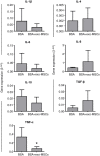Mesenchymal Stem Cell-Derived Exosomes: Immunomodulatory Evaluation in an Antigen-Induced Synovitis Porcine Model
- PMID: 28377922
- PMCID: PMC5359696
- DOI: 10.3389/fvets.2017.00039
Mesenchymal Stem Cell-Derived Exosomes: Immunomodulatory Evaluation in an Antigen-Induced Synovitis Porcine Model
Abstract
Synovitis is an inflammatory process associated with pain, disability, and discomfort, which is usually treated with anti-inflammatory drugs or biological agents. Mesenchymal stem cells (MSCs) have been also successfully used in the treatment of inflammatory-related diseases such as synovitis or arthritis. In the last years, the exosomes derived from MSCs have become a promising tool for the treatment of inflammatory-related diseases and their therapeutic effect is thought to be mediated (at least in part) by their immunomodulatory potential. In this work, we aimed to evaluate the anti-inflammatory effect of these exosomes in an antigen-induced synovitis animal model. To our knowledge, this is the first report where exosomes derived from MSCs have been evaluated in an animal model of synovitis. Our results demonstrated a decrease of synovial lymphocytes together with a downregulation of TNF-α transcripts in those exosome-treated joints. These results support the immunomodulatory effect of these exosomes and point out that they may represent a promising therapeutic option for the treatment of synovitis.
Keywords: exosomes; immunomodulation; inflammation; mesenchymal stem cells; synovitis.
Figures




Similar articles
-
Equine allogeneic umbilical cord blood derived mesenchymal stromal cells reduce synovial fluid nucleated cell count and induce mild self-limiting inflammation when evaluated in an lipopolysaccharide induced synovitis model.Equine Vet J. 2016 Sep;48(5):619-25. doi: 10.1111/evj.12477. Epub 2015 Aug 14. Equine Vet J. 2016. PMID: 26114736
-
Immunomodulatory Potential of Human Adipose Mesenchymal Stem Cells Derived Exosomes on in vitro Stimulated T Cells.Front Immunol. 2014 Nov 4;5:556. doi: 10.3389/fimmu.2014.00556. eCollection 2014. Front Immunol. 2014. PMID: 25414703 Free PMC article.
-
Mesenchymal stem cells-derived exosomes are more immunosuppressive than microparticles in inflammatory arthritis.Theranostics. 2018 Feb 3;8(5):1399-1410. doi: 10.7150/thno.21072. eCollection 2018. Theranostics. 2018. PMID: 29507629 Free PMC article.
-
Therapeutic Potential of Mesenchymal Stem Cell-Derived Exosomes in the Treatment of Eye Diseases.Adv Exp Med Biol. 2018;1089:47-57. doi: 10.1007/5584_2018_219. Adv Exp Med Biol. 2018. PMID: 29774506 Review.
-
Targeting Stem Cells in Chronic Inflammatory Diseases.Adv Exp Med Biol. 2021;1286:163-181. doi: 10.1007/978-3-030-55035-6_12. Adv Exp Med Biol. 2021. PMID: 33725353 Review.
Cited by
-
Immunosuppressive Effect of Exosomes from Mesenchymal Stromal Cells in Defined Medium on Experimental Colitis.Int J Stem Cells. 2019 Nov 30;12(3):440-448. doi: 10.15283/ijsc18139. Int J Stem Cells. 2019. PMID: 31242720 Free PMC article.
-
Novel insights into MSC-EVs therapy for immune diseases.Biomark Res. 2019 Mar 18;7:6. doi: 10.1186/s40364-019-0156-0. eCollection 2019. Biomark Res. 2019. PMID: 30923617 Free PMC article. Review.
-
Efficacy and safety of mesenchymal stem cell injections for patients with osteoarthritis: a meta-analysis and review of RCTs.Arch Orthop Trauma Surg. 2021 Jul;141(7):1241-1251. doi: 10.1007/s00402-020-03703-0. Epub 2021 Jan 28. Arch Orthop Trauma Surg. 2021. PMID: 33507375
-
Harnessing mesenchymal stem/stromal cells-based therapies for rheumatoid arthritis: mechanisms, clinical applications, and microenvironmental interactions.Stem Cell Res Ther. 2025 Jul 16;16(1):379. doi: 10.1186/s13287-025-04495-z. Stem Cell Res Ther. 2025. PMID: 40671080 Free PMC article. Review.
-
Immunosuppressive Effects of Mesenchymal Stem Cells-derived Exosomes.Stem Cell Rev Rep. 2021 Apr;17(2):411-427. doi: 10.1007/s12015-020-10040-7. Stem Cell Rev Rep. 2021. PMID: 32935222 Review.
References
LinkOut - more resources
Full Text Sources
Other Literature Sources

